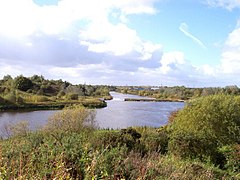Woolston, Cheshire
| Woolston | |
|---|---|
 The River Mersey at Wooston |
|
| Woolston shown within Cheshire | |
| Population | 7,868 (2001) |
| OS grid reference | SJ645895 |
| Civil parish |
|
| Unitary authority | |
| Ceremonial county | |
| Region | |
| Country | England |
| Sovereign state | United Kingdom |
| Post town | WARRINGTON |
| Postcode district | WA1 |
| Dialling code | 01925 |
| Police | Cheshire |
| Fire | Cheshire |
| Ambulance | North West |
| EU Parliament | North West England |
Formerly a township within the parish of Warrington, and now a parish in its own right, Woolston-with-Martinscroft consists of two settlements: Woolston to the west and Martinscroft to the east, which run along the north bank of the River Mersey and take in Paddington to the south-west. It is bounded by the River Mersey to the south, Bruche and Padgate to the west, Longbarn and Birchwood to the north and Rixton to the east.
The township remained an agricultural community on the furthest outskirts of Warrington until the 1970s, when development by Warrington New Town radically transformed its rural character. With the construction of the M6 motorway on its eastern side, Martinscroft lost its previous status as the main village centre. The mosses to the north were covered by the Grange Employment Estate and the last remaining farm was demolished in the late 1990s.
The parish is generally known as Woolston only. It is now a residential suburb of Warrington, popular with families, and known mostly to wildlife enthusiasts for its proximity to several nature reserves and SSSIs (Site of Special Scientific Interest). The Mersey Way long-distance footpath runs along the river bank.
The flat country is divided into fields with rather meagre hedgerows and scanty trees. The alluvial and sandy soil appears fertile, yielding good crops of potatoes and turnips, oats, wheat, and clover, whilst many a marshy corner is devoted to the cultivation of osiers for the manufacture of potato hampers and 'skips'. In the north of the district there is a considerable patch of mossland and here too there is a good deal of clay in the surface soil. By the river there are moist pastures. The inhabitants are entirely employed in agricultural labour and basketmaking. 1907 description.
The area has two main natural areas: Woolston Linear Park and the Woolston Eyes Nature Reserve—a Site of Special Scientific Interest.
...
Wikipedia

